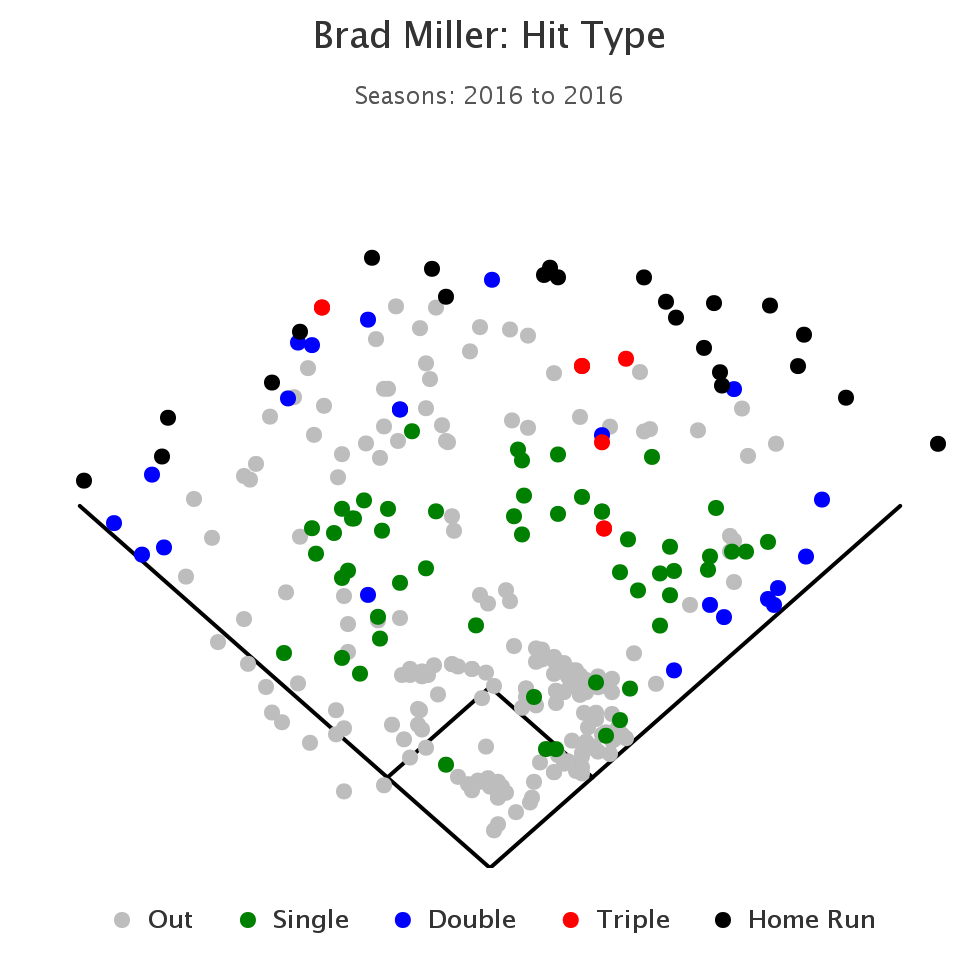Brad Miller's Increase in Power Is Leading to a Career Year

Based on the way Brad Miller has played for the Tampa Bay Rays this season, it's likely that the Seattle Mariners regret letting him go. Last winter, Seattle sent Miller along with Logan Morrison and Danny Farquhar to Tampa Bay for Nate Karns, C.J. Riefenhauser (who is no longer in their system) and minor leaguer Boog Powell.
It's easy to say that now, of course, but at the time of the trade, Miller had just completed a season in which he slashed .258/.329/.402 and was worth only 0.9 Wins Above Replacement (fWAR), according to FanGraphs, in 497 plate appearances. He primarily played shortstop, but he also saw time at second base, third base and all three outfield spots.
In three seasons with the Mariners, Miller hit 29 home runs in 1,243 plate appearances and posted an ISO of just .147. Power want not his game. His wRC+ during this time was 99, suggesting he was a league-average, replaceable player.
It's tough to blame Seattle for choosing to move on from him, but some changes to Miller's swing this season and an apparent new approach at the plate has led to impressive power, resulting in a career year for the 26 year-old.
Leg-Kicking Things Up a Notch
Check out this clip from last season and pay attention to Miller's front leg.
Minus a toe-tap, there isn't much movement in Miller's front leg. He also falls off the to side when finishing his hack. Now check out how his swing looks this season, again watching his right leg.
Notice the big leg kick? And how he stayed balanced throughout his swing? That's a huge difference from how Miller's looked at the plate with the Mariners, and it could be why he's had success driving the ball this season.
That home run above gave Miller 19 taters on the season -- 8 more than his previous career high. He's hit 6 more since then -- including 5 in his last five games -- to give him 25 on the year.
Only two hitters who qualify as shortstops this season have more longballs (Trevor Story with 27 and Manny Machado with 26) and only one (Story) has a higher ISO than Miller's .265, which ranks 11th best among all hitters. Miller's previous career-best ISO was .154, which came during the 2013 season.
Power Surge
Along with changes to his swing, Miller's approach at the plate could be another reason why he's been able to hit for significantly more power.
Below is a table which shows the percentage of fly balls Miller has put in play (FB%) for his career, what the total is this season and what it is in the second half. It also includes the percentage of balls he has pulled (Pull%) for these same three categories, as well as his hard-hit rate (Hard%).
| Situation | FB% | Pull% | Hard% |
|---|---|---|---|
| Prior to 2016 | 33.9 | 36.9 | 29.8 |
| 2016 | 35.6 | 41.4 | 33.9 |
| Second half | 37.0 | 48.2 | 39.5 |
As you can see, Miller is hitting more fly balls, pulling the ball more and overall, just hitting the ball a lot harder. His first-half numbers were a nice improvement, but he's really exploded after the break.
While he's pulling the ball more, Miller has shown the ability to hit for power to all fields.

You'll notice some black dots -- signifying home runs -- to the left side of center field, but the amount of home runs alone that Miller has pulled this season are more than he's hit for in an entire season prior to this year. Hitting more pulled, hard-hit fly balls is a great way to increase homers, and only two players have hit more taters in the second half than Miller's 11 bombs.
On a Tear
Since returning from the All-Star break, Miller has been among baseball's best hitters, outside of just hitting home runs. He ranks third in ISO (.391), fourth in both slugging percentage (.718) and wRC+ (199), fifth in wOBA (.461) and sixth in fWAR (1.7).
Based on fWAR, Miller has been better in the second half than guys like Mike Trout, Josh Donaldson and Kris Bryant, who are all having superb campaigns. Miller has also had to deal with playing a new position.
Putting it all together, Miller's season-long slugging percentage is .530, his wOBA is .357 and his wRC+ is 128, all of which are well above his previous single-season career bests. The current league average for these stats are .418, .318 and 96, respectively, meaning Miller has very clearly moved on from his designation as an easily replaceable player.
Rest-of-Season Outlook
We project his power to taper off as the season winds down, forecasting a .786 OPS over the rest of the year. Miller currently owns an .850 OPS, easily a career high. We also project him to hit 6 more home runs, which would give Miller 31 for the year.
While he's recently switched to playing first base to make room for Matthew Duffy -- who was acquired from the San Francisco Giants as part of the Matt Moore trade -- a shortstop hasn't hit 30 homers in a season since 2011.
Further rubbing salt in the Mariners' wound of letting Miller go, since Alex Rodriguez left via free agency after the 2000 season, they've only had two seasons since in which a shortstop hit double-digit home runs, and they were both Miller during the 2014 and 2015 campaigns.
In other words, taking Miller out of the equation, the Mariners haven't had a shortstop hit more than nine home runs in a season since 2000, a trend that will continue this year, as the five players to appear at the position for Seattle this year have five home runs combined. I'm guessing they'd like to have Miller's newfound power back on their roster.
















